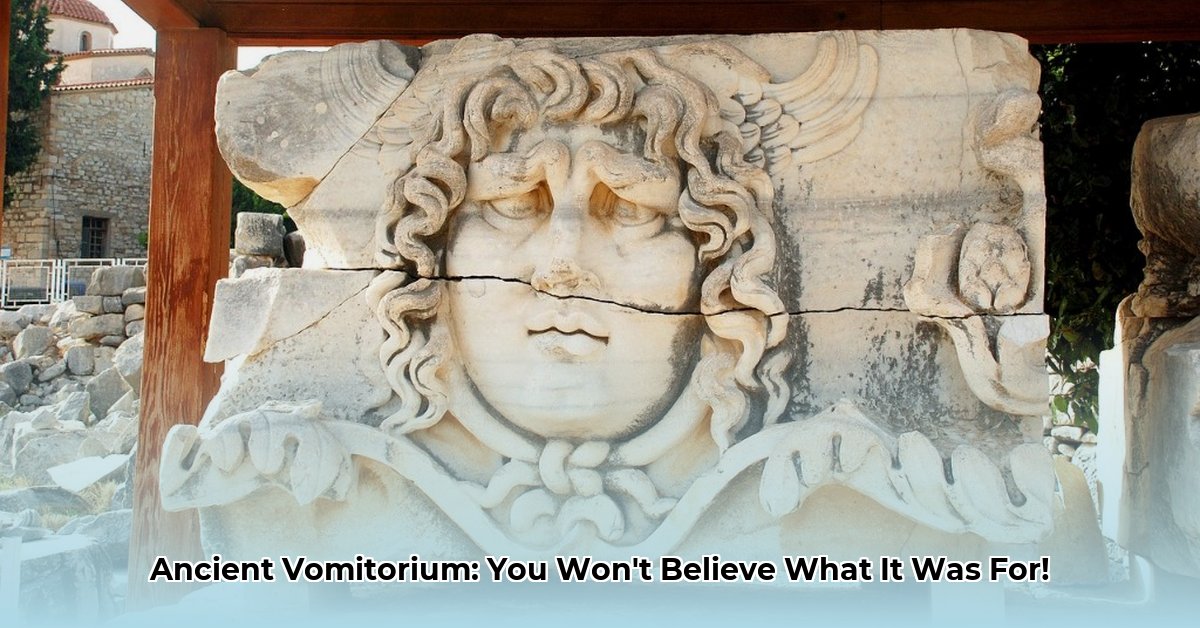The image of ancient Romans gorging themselves at lavish feasts, only to retreat to a designated “vomitorium” to purge and continue eating, is a striking and pervasive cultural trope. It paints a vivid picture of Roman excess and decadence, appearing in popular fiction and historical anecdotes alike. However, this sensationalized portrayal is fundamentally flawed. The reality of the vomitorium in ancient Rome is far more practical, demonstrating the Romans’ remarkable ingenuity in urban planning and crowd management, rather than their gluttony. Prepare to uncover the true purpose of these misunderstood architectural marvels, shattering a prominent historical misconception.
Unpacking the Linguistic Roots: The True Meaning of “Vomitorium”
The widespread confusion surrounding the vomitorium stems primarily from a linguistic misunderstanding. While the modern English word “vomit” undeniably suggests expulsion from the stomach, the Latin root “vomere” carries a broader meaning: “to spew forth,” “to erupt,” or “to rapidly discharge.” When a fifth-century writer, Macrobius, coined the term “vomitorium” in his Saturnalia, he was not referring to a place of physical purging. Instead, he employed the “orium” suffix (denoting a place) to describe the architectural features of Roman theaters and amphitheaters that efficiently “spewed forth” or discharged vast crowds of people into and out of the seating areas.
These Roman architectural designs were brilliant solutions for crowd control. Imagine thousands of spectators needing to enter and exit a massive arena like the Colosseum in a short timeframe. The vomitoria were wide, vaulted passageways or entrances/exits that facilitated this rapid, orderly flow. They were essential conduits for public movement, ensuring safety and efficiency within grand public spaces.
The Myth’s Origins: From Ancient Satire to Modern Misinterpretation
If the vomitorium was a testament to Roman pragmatic design, how did the myth of a “vomit room” take such strong hold? The answer lies in a combination of ancient social commentary and later linguistic error, amplified by popular culture.
Ancient Roman writers, particularly satirists and moral philosophers, often criticized the perceived excesses of their wealthy contemporaries. Seneca, a Stoic philosopher, famously wrote passages vividly describing the gluttonous habits of Roman elites, noting that “they vomit so they may eat, and eat so that they may vomit.” Similarly, Petronius’s satirical novel, the Satyricon, features outlandish feasts hosted by characters like Trimalchio, showcasing extravagant and often grotesque dining practices. These accounts, while intended as social critiques or exaggerated satires, inadvertently contributed to the image of Romans as an inherently emetic or excessively indulgent society.
Historians and archaeologists, through studies of Roman diets based on skeletal and dental analysis, reveal a more nuanced picture. While the wealthy did enjoy more varied and luxurious foods like meat and fine wines, the staple diet for most Romans, rich or poor, remained grain-based. The idea of widespread, ritualistic binging and purging was not a common practice, even among the elite, but rather an exaggerated portrayal designed to critique lavish lifestyles.
The crucial turning point for the modern myth appears to have occurred in the late 19th or early 20th century. A simple linguistic misinterpretation of “vomitorium” combined with the pre-existing trope of gluttonous Romans, perpetuated by literary works like Aldous Huxley’s 1923 novel Antic Hay, which incorrectly depicted vomitoria as rooms for purging. This unfortunate blend of historical satire and modern fiction cemented the false narrative in the public consciousness, overshadowing the true historical context of Roman engineering.
Engineering Mastery: The Colosseum’s Crowd Management System
To fully appreciate the true function of the vomitorium, one must look no further than the iconic Colosseum in Rome. This immense amphitheater, capable of holding an estimated 50,000 to 80,000 spectators, stands as a prime example of Roman urban planning and architectural genius. Its intricate system of arches, staircases, and, crucially, its numerous vomitoria, allowed for an astonishingly efficient flow of people. Historical calculations suggest that the Colosseum could be filled or emptied in approximately 10 to 15 minutes, a feat of rapid stadium crowd movement that rivals many modern venues.
These strategically placed passageways were not merely exits and entrances; they were integral to the social organization of Roman public spaces. They often led directly to specific seating sections, reflecting the rigid class hierarchy of Roman society. Different social strata were directed through designated vomitoria to their allocated areas, minimizing chaos and maintaining order within the vast structure. The precision and forethought demonstrated in the Colosseum’s design highlight the Romans’ advanced understanding of public logistics and efficient ancient Roman crowd control systems.
The Enduring Legacy: From Ancient Rome to Modern Urban Planning
The persistence of the vomitorium myth underscores how easily historical misconceptions can become entrenched, particularly when fueled by dramatic imagery and linguistic similarities. Despite archaeological and historical evidence to the contrary, the “vomit room” narrative continues to captivate, largely because of its sensational nature, the inherent suggestiveness of the word itself, and its repeated appearances in popular culture.
However, moving beyond this entertaining but false tale reveals a far more significant truth about Roman innovation. The principles behind the vomitorium – efficient entry and exit points, logical flow pathways, and rapid dispersal strategies – are not just historical footnotes. They form the foundational concepts of modern crowd management and urban design. Contemporary stadiums, concert halls, airports, and public transportation hubs all utilize descendants of these ancient Roman principles to ensure safety, reduce congestion, and facilitate the movement of large populations.
By understanding the true purpose of the vomitorium, we gain a deeper appreciation for the Romans’ pragmatic brilliance. It wasn’t a symbol of their excess, but rather a testament to their unparalleled skill in Roman infrastructure and their ability to engineer solutions for the practical challenges of managing a vast, complex society. The myth has been debunked; the architectural marvel, and its lasting influence on our built environment, endure.










